How to Frenchify Your Hanukkah
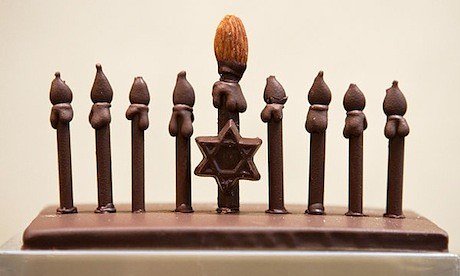
Mon 2 Dec 2013
This year the stars aligned to create a superholiday, Thanksgivukkuh (it won’t come around for about another 76,000 years, so I hope you made the best of it!). Now that the pumpkin latkes and challah stuffing are all gone, you might need a pick-me-up to get you through the rest of the year. How about Frenchifying your Hanukkah? I checked with some of the best Paris blogs to find ways to add a little je ne sais quoi to the last few days of the festival of light with new traditions and delicious recipes.
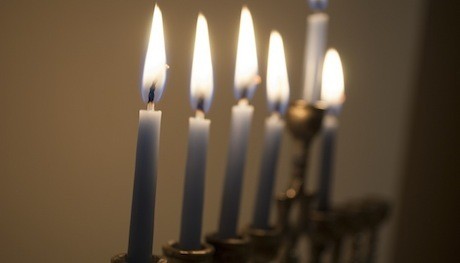
Start Frenchifying your Hanukkah by incorporating some French recipes (see below) to your Hanukkah meal. One thing that you’ll always find in Hanukkah recipes is lots and lots of oil (representing the oil miraculously burning for eight days). These French recipes will definitely kick it up a notch and give you something to look forward to after Thanksgivukkuh.
In Alsace there are many traditional French Hanukkah recipes. They’re delicious and a little different from those at any Hanukkah meal I’ve ever had! This time of year, goose is a popular menu item in France, which is why meat cooked in goose fat is quite common on the French Hanukkah dinner table. You’ll typically find it garnished with Alsatian sauerkraut, served with mustard and a clean white wine. Or for something a bit more fun, make Hanukkah fondue. It’s French, it’s delicious and meat cooked in hot oil screams Hanukkah—you’re probably surprised you didn’t think of it before!
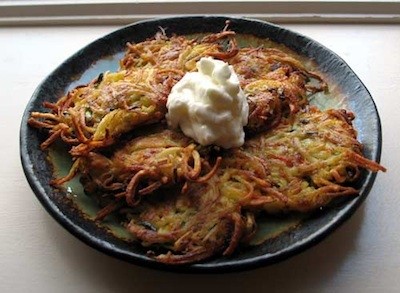
Gretchenes latkes. Photo via chicagonow.com.
If meat cooked in goose fat is not your thing (I am vegetarian after all), try foregoing traditional potato latkes for something with a bit of a French twist. These traditional gretchenes latkes use blé noir (buckwheat flour), and onion instead of potato. Fry them in a nut or seed oil, like walnut or safflower, for a truly delicious and French treat. Eating them with applesauce and sour cream is still a must!
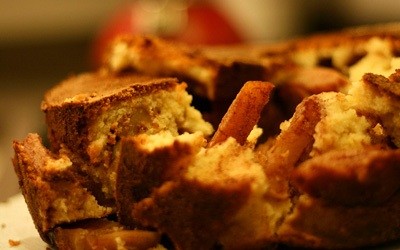
Gâteau de Hannouka. Photo via whyy.org.
Instead of fried donuts for dessert, try making a gâteau de Hannouka. In honor of Hanukkah, oil is substituted for butter in this delightful French cake recipe. This particular version comes from Joan Nathan’s Quiches, Kugels, and Couscous: My Search for Jewish Cooking in France.
I am particularly fond of a Hanukkah tradition from Avignon. After Shabbat, during Hanukkah, Jews in Avignon go from house to house, opening and tasting new wines. Even if you don’t go house-hopping with your neighbors, invite some friends and neighbors over and sample a selection of new (or old) French wines. This tradition is an easy and delicious one to incorporate into any Hanukkah celebration.
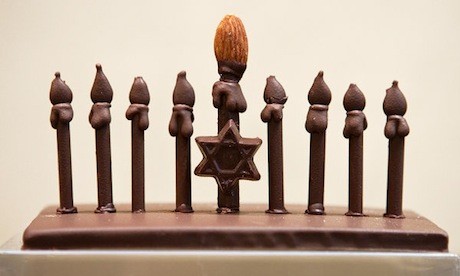
Chocolate menorah by Michel Cluizel. Photo via nytimes.com.
Another French twist on an essential part of Hanukkah is a chocolate menorah from Michel Cluizel. If you do nothing else, a chocolate menorah will guarantee a truly Frenchified and delicious Hanukkah.
Alsatian Sauerkraut
Typically served on the first or last night of Hanukkah
Recipe via French Jewish Traditions and Recipes
Serves 8
3 pounds sauerkraut
2 packages of hot dogs
1 big onion, peeled, not sliced
4 cloves
1 teaspoon juniper berries
salt and pepper
1 teaspoon peppercorns
1 potato per person, washed but not peeled
1/4 bottle very dry white wine (Pinot or Alsatian white wine)
4 tablespoon oil
Drain the sauerkraut, and then rinse it in a large cooking bowl of cool water. Drain. Repeat this process two more times. Press the cloves into the onion, so it is studded with the cloves at intervals. In a large pot or a Crock-Pot, place the oil, sauerkraut, prepared onion, peppercorns and salt. Add the white wine. Add enough water to nearly cover the sauerkraut mixture.
Cook, covered, on medium-low heat for about 1 hour (high heat in a Crock-Pot ). Uncover and lay the whole potatoes on top of the sauerkraut, partially submerged in the water. Cover and cook on low heat an additional hour, until potatoes are fork-tender. The water should reduce to almost none, but you may need to add water to extend the cooking time for the potatoes. The longer it cooks the better.
When the potatoes are nearly cooked, add the hot dogs to the pot. Layer the potatoes, sauerkraut and hot dogs on a platter. As a side dish, serve a platter of salami and pickles. Accompany the meal with white wine, or beer, if desired.
Gretchenes Latkes
From Joan Nathan’s Quiches, Kugels, and Couscous: My Search for Jewish Cooking in France
Makes 8 latkes
1 cup buckwheat flour
1 teaspoon salt
1 teaspoon baking powder
2 large eggs
2 cups grated onions (about 2 medium)
vegetable oil for frying
sour cream or applesauce for garnish
1. Stir the flour, salt, and baking powder together in a small bowl. Beat in the eggs, mixing well. Then stir in the onions.
2. Heat a nonstick frying pan and add a film of oil. Ladle about 2 tablespoons of the flour mixture into the frying pan and heat, frying until golden, then flip and cook the second side.
3. Eat alone or with sour cream or applesauce.
Gâteau de Hannouka
From Joan Nathan’s Quiches, Kugels, and Couscous: My Search for Jewish Cooking in France
Makes 8–10 servings
1 cup vegetable oil, plus more for greasing pan
5 apples (3 Fuji and 2 Granny Smith, or any combination of sweet and tart apples), peeled, cored, and cut into ½-inch pieces (about 6 cups)
grated zest and juice of 1 lemon
1/3 cup walnut halves, roughly chopped
1½ teaspoons ground cinnamon
2 cups all-purpose flour
1 teaspoon baking powder
1/8 teaspoon salt
2 tablespoons chopped almonds
1¼ cups plus 2 tablespoons sugar
4 large eggs
¼ teaspoon almond extract
1. Preheat the oven to 350 degrees, and grease a Bundt pan or a 9-by-13-inch baking pan. Toss the apples in a large bowl with the zest and juice of the lemon, the walnuts, and the cinnamon.
2. Pulse together the flour, baking powder, salt, almonds, and 1¼ cups of the sugar in the bowl of a food processor fitted with a steel blade. With the food processor running, add the eggs, oil, and almond extract, processing until just mixed.
3. Spoon 1/3 of the batter over the bottom of the pan. Scatter the apples on top, and cover the apples with the remaining batter. Sprinkle the top with the remaining 2 tablespoons sugar (you’ll need less if using a Bundt pan).
4. Bake for 45 to 60 minutes, or until golden and cooked through. The cake will take a shorter time to bake in the shallow rectangular pan than in the Bundt pan.
Like this article? Sign up for our newsletter and get more of the latest scoop from Paris delivered directly to your in-box.